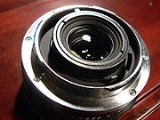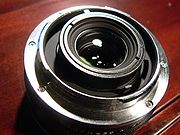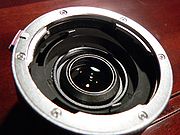
Leica R bayonet
Encyclopedia


Lens mount
A lens mount is an interface — mechanical and often also electrical — between a photographic camera body and a lens. It is confined to cameras where the body allows interchangeable lenses, most usually the single lens reflex type or any movie camera of 16 mm or higher gauge...
is the standard method of connecting a lens to the Leica R series of 35 mm
135 film
The term 135 was introduced by Kodak in 1934 as a designation for cartridge film wide, specifically for still photography. It quickly grew in popularity, surpassing 120 film by the late 1960s to become the most popular photographic film format...
single-lens reflex camera
Camera
A camera is a device that records and stores images. These images may be still photographs or moving images such as videos or movies. The term camera comes from the camera obscura , an early mechanism for projecting images...
s. The mount is descended from those used for the Leicaflex
Leicaflex
The Leicaflex was the first series of 35mm single-lens reflex cameras manufactured by Leitz. The Leicaflexes were fully mechanical cameras marketed between 1964 and 1976, in response to the rapid increase in popularity and usability of SLRs during this period...
, Leicaflex SL
Leicaflex SL
The Leicaflex SL was a SLR made by Leitz from 1968 to 1974 as the second iteration of the Leicaflex series.In 1968, Leitz responded to the critics of the non-TTL meter of the original Leicaflex by introducing its successor the Leicaflex SL with a TTL meter...
and Leicaflex SL2
Leicaflex SL2
The Leicaflex SL2 was a SLR made by Leitz from 1974 as the third iteration of the Leicaflex series.The modifications from the Leicaflex SL were relatively minor:* addition of an aperture read-out in the finder...
SLR cameras, but differs in the cams used to communicate lens aperture information to the camera. Some lenses are compatible with all of the Leica SLR cameras, while R-only lenses have a slightly different mount shape which will not fit on the earlier cameras.
The flange focal distance
Flange focal distance
For an interchangeable lens camera, the flange focal distance of a lens mount system is the distance from the mounting flange to the...
between mount and film is 47 mm.
The modern apochromatic manual focus Leica R lenses are especially notable for their world class optical performance, for example, 90mm f/2 AA, 100mm f/2.8 Macro, 180mm f/2, 180mm f/2.8, and 280mm f/4.
On 5 March 2009, Leica announced plans to cease production of its R-Series manual focus SLR and lenses.
One-cam lenses
One-cam lenses have a cam that only works to communicate aperture information to the original Leicaflex camera. They can be used on later cameras in stop-down metering mode only. Leica do not recommend that they be used on R8Leica R8
The Leica R8 is a manual focus 35 mm single-lens reflex camera produced by the German firm of Leica as part of their R series of cameras. Development began in 1990:...
or R9
Leica R9
The Leica R9 is a manual focus 35 mm single-lens reflex camera produced by the German firm of Leica as part of their R series of cameras. It was released in 2002, replacing the very similar Leica R8, upon which it improved in several aspects...
cameras because if the cam is out of specification it may damage those cameras' ROM contacts. One-cam lenses may be converted to work fully on later cameras.
Two-cam lenses
Two-cam lenses have cams for the Leicaflex and also for the SL and SL2. They can be used on R cameras in stop-down metering mode; again, Leica does not recommend that they be used on the R8/R9, and they can be modified to work fully with R cameras.Three-cam lenses
These have a third "R-Cam" fitted that communicates aperture information to R-series cameras. They work with all Leica SLR models, because they have all three methods of communication.R-only lenses
These only have the R-cam, and only work on R-series cameras. The mount is deliberately incompatible with the Leicaflex models. May be converted to three-cam by a technician.ROM lenses
These only have the R-cam, but in addition have electrical contacts allowing the lenses to communicate information to the camera, such as the lens' focal length. This is only supported on the R8/R9, although the lenses will also mount and work on earlier R cameras. The info is used in flash metering and also communicated to the flash unit, where it can be used to set power and flash zoom correctly.On other cameras
The flange focal distance of 47 mm is fairly large, meaning that few other systems' lenses can be adapted to fit on a Leica R and retain infinity focus, but R lenses can be converted to other systems. The distance is only 0.5 mm larger than the Nikon F-mountNikon F-mount
The Nikon F-mount is a type of interchangeable lens mount developed by Nikon for its 35 mm SLR cameras. The F-mount was first introduced on the Nikon F camera in 1959, and features a three lug bayonet mount with a 44 mm throat and a flange to focal plane distance of 46.5 mm...
, which is not sufficient to make a workable adapter; however, at least one Nikon camera has been modified with a Leica R bayonet mount to take R lenses.
A number of manufacturers have produced adapters to allow Canon EOS
Canon EOS
The Canon EOS autofocus 35 mm film and digital SLR camera system was introduced in 1987 with the Canon EOS 650 and is still in production as Canon's current DSLR system...
cameras to take R lenses; these operate only in stop-down metering mode, but function well when rapid operation is not required.
See also
- Leica M mountLeica M mountThe Leica M mount is a camera lens mount introduced in 1954 with the Leica M3, and a range of lenses. It has been on all the Leica M series up to the current film Leica M7 and digital Leica M9....
----

